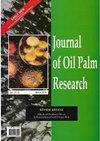THE PROGRESS OF AUTHENTICATION ANALYSIS OF FATS AND OILS USING VIBRATIONAL SPECTROSCOPY AND CHEMOMETRICS ANALYSIS: NARRATIVE REVIEW
IF 1.3
4区 农林科学
Q2 Agricultural and Biological Sciences
引用次数: 0
Abstract
Food authenticity, including edible oils and fats (EOFs), is an interesting issue since unethical players try to adulterate high priced EOFs with lower priced oils to gain the economical profits. Vibrational spectroscopy (VS) is considered a fingerprinting analytical tool capable of differentiating authentic and unauthentic fats and oils. Combined with multivariate data analysis or chemometrics, VS has been reported as the common method used for the authentication of EOFs. Chemometrics has been defined as the science providing the extraction of chemical data to get the maximum information employing statistics and mathematical methods. VS of EOFs involved very large chemical data and therefore the use of chemometrics is a must. The main objective of this review was to highlight the employment of VS in combination with chemometrics for the authentication of EOFs. In order to achieve this purpose, a search strategy using databases of SCOPUS, PubMed and DOAJ along with several keywords was carried out. VS such as Fourier transform infrared (FTIR), near infrared (NIR), and Raman spectroscopy in conjunction with chemometrics offered the most reliable outcome for the authentication analysis of EOFs. In addition, the combination of VS and chemometrics is a rapid and reliable analytical method with minimum sample preparation. Among those techniques, FTIR and NIR spectroscopy combined with chemometrics offer a more effective and efficient technique for the authentication of EOFs.振动光谱和化学计量学在油脂鉴定分析中的研究进展&叙述性综述
食品的真实性,包括食用油和脂肪(EOF),是一个有趣的问题,因为不道德的参与者试图用低价的油掺假高价的EOF,以获得经济利润。振动光谱(VS)被认为是一种指纹分析工具,能够区分真实和不真实的脂肪和油。结合多变量数据分析或化学计术,VS已被报道为EOF认证的常用方法。化学计量学被定义为利用统计学和数学方法提取化学数据以获得最大信息的科学。EOF的VS涉及非常大的化学数据,因此必须使用化学计量学。这篇综述的主要目的是强调VS与化学计学相结合用于EOF认证的应用。为了实现这一目的,使用SCOPUS、PubMed和DOAJ数据库以及几个关键词进行了搜索策略。傅立叶变换红外光谱(FTIR)、近红外光谱(NIR)和拉曼光谱等VS与化学计学相结合,为EOF的认证分析提供了最可靠的结果。此外,VS和化学计量学的结合是一种快速可靠的分析方法,样品制备量最小。在这些技术中,FTIR和NIR光谱与化学计量学相结合,为EOF的认证提供了一种更有效的技术。
本文章由计算机程序翻译,如有差异,请以英文原文为准。
求助全文
约1分钟内获得全文
求助全文
来源期刊

Journal of Oil Palm Research
农林科学-食品科技
CiteScore
2.60
自引率
30.80%
发文量
69
审稿时长
>12 weeks
期刊介绍:
JOURNAL OF OIL PALM RESEARCH, an international refereed journal, carries full-length original research papers and scientific review papers on various aspects of oil palm and palm oil and other palms. It also publishes short communications, letters to editor and reviews of relevant books. JOURNAL OF OIL PALM RESEARCH is published four times per year, i.e. March, June, September and December.
 求助内容:
求助内容: 应助结果提醒方式:
应助结果提醒方式:


